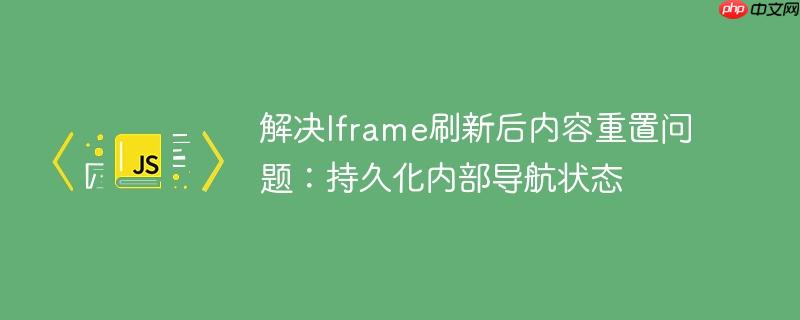
<iframe> 元素本身并不会记忆其内部的导航历史。当包含 <iframe> 的父页面进行刷新时,<iframe> 会被重新渲染,并加载其 src 属性所指定的初始url。这意味着,如果用户在 <iframe> 内部进行了多次页面跳转,这些内部导航状态在页面刷新后都会丢失。为了保持用户在 <iframe> 中的当前位置,我们需要主动介入,捕获并持久化其状态。
这种方法的核心思想是在Iframe内部导航发生变化时,将Iframe的当前URL保存到浏览器的本地存储中(如sessionStorage或localStorage)。当父页面重新加载时,从存储中读取该URL,并将其设置为Iframe的src,从而恢复Iframe的先前状态。
由于浏览器同源策略的限制,如果Iframe和父页面不同源,父页面将无法直接访问Iframe内部的window.location.href。因此,以下示例代码假设Iframe和父页面是同源的。如果不同源,需要Iframe内部通过postMessage向父页面发送消息来同步URL。
在同源情况下,我们可以通过监听Iframe的load事件来得知其内容已经加载完成,此时可以获取其当前的URL。
// 获取Iframe元素
const iframe = document.getElementById('frame');
// 监听Iframe的load事件
iframe.addEventListener('load', function() {
try {
// 尝试获取Iframe内部的当前URL
// 注意:这只在同源策略下有效
const currentIframeUrl = iframe.contentWindow.location.href;
console.log('Iframe已加载,当前URL:', currentIframeUrl);
// 将URL保存到sessionStorage
sessionStorage.setItem('iframeLastUrl', currentIframeUrl);
} catch (e) {
console.warn('无法访问Iframe内容,可能存在同源策略限制:', e);
// 如果无法访问,则不保存状态
}
});注意事项:
当父页面重新加载时,我们需要检查sessionStorage或localStorage中是否存在之前保存的Iframe URL。如果存在,则将Iframe的src属性设置为该URL。
document.addEventListener('DOMContentLoaded', function() {
const iframe = document.getElementById('frame');
const storedIframeUrl = sessionStorage.getItem('iframeLastUrl');
if (storedIframeUrl) {
// 如果有保存的URL,则恢复Iframe状态
iframe.src = storedIframeUrl;
console.log('Iframe状态已从sessionStorage恢复:', storedIframeUrl);
} else {
// 如果没有保存的URL,则加载初始src
console.log('未找到保存的Iframe状态,加载初始src:', iframe.src);
}
// 重新绑定监听,确保后续导航也能被捕获
iframe.addEventListener('load', function() {
try {
const currentIframeUrl = iframe.contentWindow.location.href;
sessionStorage.setItem('iframeLastUrl', currentIframeUrl);
} catch (e) {
console.warn('无法访问Iframe内容,可能存在同源策略限制:', e);
}
});
});sessionStorage vs localStorage:
这种方法更推荐,因为它不仅解决了刷新问题,还使得Iframe的状态可以被URL共享。核心思想是利用父页面的URL来编码Iframe的当前状态。当Iframe内部导航时,父页面会更新自身的URL,将Iframe的路径作为查询参数或URL片段(hash)的一部分。当页面刷新时,父页面会解析URL,提取Iframe的路径,并据此设置Iframe的src。
history.pushState() 是HTML5 History API的一部分,允许我们修改浏览器的历史记录和URL,而无需重新加载页面。这使得我们可以在不刷新父页面的情况下,更新其URL以反映Iframe的内部状态。
假设父页面的URL结构为 https://parent.com/app?iframePath=/page2。
步骤:
Iframe加载时更新父页面URL: 当Iframe内部导航发生时(同源情况下通过load事件或Iframe内部主动postMessage),父页面获取Iframe的当前路径,并使用history.pushState()更新父页面的URL。
// 父页面脚本
const iframe = document.getElementById('frame');
iframe.addEventListener('load', function() {
try {
const currentIframePath = iframe.contentWindow.location.pathname + iframe.contentWindow.location.search + iframe.contentWindow.location.hash;
// 构建新的父页面URL,例如:将Iframe路径作为查询参数
const newParentUrl = new URL(window.location.href);
newParentUrl.searchParams.set('iframePath', currentIframePath);
// 更新父页面URL,不触发页面刷新
history.pushState({ iframePath: currentIframePath }, '', newParentUrl.toString());
console.log('父页面URL已更新以反映Iframe状态:', newParentUrl.toString());
} catch (e) {
console.warn('无法访问Iframe内容,可能存在同源策略限制:', e);
}
});父页面加载时解析URL恢复Iframe状态: 当父页面首次加载或刷新时,解析当前URL中的iframePath参数。如果存在,则将其作为Iframe的src。
// 父页面脚本
document.addEventListener('DOMContentLoaded', function() {
const iframe = document.getElementById('frame');
const urlParams = new URLSearchParams(window.location.search);
const iframePathFromUrl = urlParams.get('iframePath');
if (iframePathFromUrl) {
// 假设Iframe的base URL是 'https://my-domain.com'
// 实际应用中,你需要根据Iframe的初始src来构建完整的URL
const iframeBaseUrl = 'https://my-domain.com'; // 替换为你的Iframe实际域名
iframe.src = iframeBaseUrl + iframePathFromUrl;
console.log('Iframe状态已从父页面URL恢复:', iframe.src);
} else {
// 如果URL中没有iframePath,则加载Iframe的初始src
console.log('父页面URL中未找到Iframe状态,加载初始src:', iframe.src);
}
// 绑定load事件监听,确保后续导航也能更新父页面URL
iframe.addEventListener('load', function() {
try {
const currentIframePath = iframe.contentWindow.location.pathname + iframe.contentWindow.location.search + iframe.contentWindow.location.hash;
const newParentUrl = new URL(window.location.href);
newParentUrl.searchParams.set('iframePath', currentIframePath);
history.pushState({ iframePath: currentIframePath }, '', newParentUrl.toString());
} catch (e) {
console.warn('无法访问Iframe内容,可能存在同源策略限制:', e);
}
});
});Iframe刷新后内容重置是一个常见的交互问题,但通过适当的JavaScript策略可以有效解决。
在选择策略时,请务必考虑Iframe与父页面是否同源,以及对URL共享的需求。对于大多数现代Web应用,推荐使用结合父页面路由的方法,以提供最佳的用户体验。
以上就是解决Iframe刷新后内容重置问题:持久化内部导航状态的详细内容,更多请关注php中文网其它相关文章!

每个人都需要一台速度更快、更稳定的 PC。随着时间的推移,垃圾文件、旧注册表数据和不必要的后台进程会占用资源并降低性能。幸运的是,许多工具可以让 Windows 保持平稳运行。




Copyright 2014-2025 https://www.php.cn/ All Rights Reserved | php.cn | 湘ICP备2023035733号